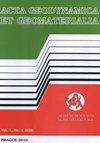几何钉布置对土钉墙性能影响的研究:物理与数值模拟
IF 0.8
4区 地球科学
Q4 GEOCHEMISTRY & GEOPHYSICS
引用次数: 1
摘要
土钉支护是一种稳定土石边坡的可靠方法,但土钉的几何布局尚未得到很好的研究。目前的研究使用分析和物理模型检验了土钉几何布局的影响。给出了不同钉子布局的极限平衡分析结果。离心机型号的目标重力水平为50 g,所有型号在该水平下的安全系数均为1.35。研究的参数包括基钉长度、钉尾延伸角度、钉的水平间距和钉密度。极限平衡结果表明,当使用较长的钉子时,钉子密度可以降低。离心机建模的结果证实,在相似的安全系数下,不同的布局并没有显示出相似的位移水平。钉密度是影响土钉墙性能的最大参数。观察到墙顶位移和钉子密度之间存在经验关系。在预测滑面和物理建模过程中形成的滑面之间观察到了有趣的相似性。文章信息本文章由计算机程序翻译,如有差异,请以英文原文为准。
Studying the effect of geometrical nail layout on the performance of soil-nailed walls: Physical and numerical modeling
Soil nailing is a reliable method of stabilising earth and rock slopes, but the geometrical layout of soil nails has not been well studied. The current research examined the effect of the geometrical layout of soil nails using analytical and physical modelling. The results of limit equilibrium analysis for different nail layouts are presented. The target gravity level was 50 g for centrifuge models and all models had a safety factor of 1.35 at this level. The parameters studied were base nail length, angle of nail tail extension, horizontal spacing of nails, and nail density. The limit equilibrium results showed that, when longer nails were used, the nail density could be decreased. The results of centrifuge modelling confirmed that different layouts at a similar safety factor did not show similar levels of displacement. Also, nail density was the most influential parameter affecting soil-nailed wall performance. An empirical relationship was observed between displacements of the wall crest and nail density. An interesting similarity was observed between the predicted slip surface and the slip surface that formed during physical modelling. ARTICLE INFO
求助全文
通过发布文献求助,成功后即可免费获取论文全文。
去求助
来源期刊

Acta Geodynamica et Geomaterialia
地学-地球化学与地球物理
CiteScore
2.30
自引率
0.00%
发文量
12
期刊介绍:
Acta geodynamica et geomaterialia (AGG) has been published by the Institute of Rock Structures and Mechanics, Czech Academy of Sciences since 2004, formerly known as Acta Montana published from the beginning of sixties till 2003. Approximately 40 articles per year in four issues are published, covering observations related to central Europe and new theoretical developments and interpretations in these disciplines. It is possible to publish occasionally research articles from other regions of the world, only if they present substantial advance in methodological or theoretical development with worldwide impact. The Board of Editors is international in representation.
 求助内容:
求助内容: 应助结果提醒方式:
应助结果提醒方式:


